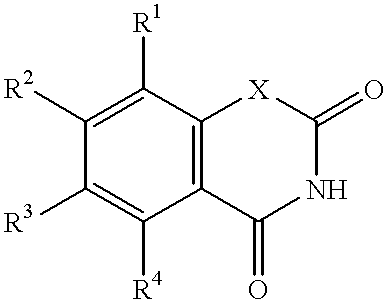Production method for a photothermographic material and a recording process
a production method and technology of photothermographic materials, applied in the field of photothermographic materials and recording processes, can solve the problems of poor stability of materials and very inefficient production methods, and achieve excellent image-forming properties
- Summary
- Abstract
- Description
- Claims
- Application Information
AI Technical Summary
Benefits of technology
Problems solved by technology
Method used
Image
Examples
invention examples 2 to 28
The materials of invention examples 2 to 28 were prepared as described for invention example 1 except that the aqueous solution of the onium polyhalide, 3-(triphenyl-phosphonium)propionic acid bromide perbromide (PC01), was replaced by aqueous solutions of the onium polyhalides given in table 1 and different molar concentrations of these onium polyhalides with respect to silver behenate were used.
From table 1it can be seen that in the case of the phosphonium halide PC03, invention examples 4 to 7, a good image was obtainable at PC03 concentrations of between 8 and 0.5 mol % with respect to silver behenate, indicating a surprising constancy of photosensitivity with decreasing molar concentration of PC03 and hence of the silver iodide formed therefrom. This result enables photothermographic recording materials to be produced with lower silver halide contents and hence enhanced intrinsic stabilities without sacrificing photosensitivity.
invention example 29
The material of invention example 29 was prepared as described for invention example 1 except that the silver behenate dispersion was prepared by the process described in the unpublished European patent application number 95201968.5. 60 g of gelatin was dissolved in 1500 g of deionized water in a reaction vessel and the resulting solution heated to 75.degree. C. The UAg, defined as the potential difference between a silver electrode (of .gtoreq.99.99% purity) in the liquid and a reference electrode consisting of a Ag / AgCl-electrode in 3M KCl solution at room temperature connected to the liquid via a salt bridge consisting of a 10% KNO.sub.3 salt solution, was adjusted to 400 mV. To this solution were simultaneously metered into the reaction vessel a solution of sodium behenate in a mixture of deionized water and 2-propanol at 80.degree. C. and an aqueous solution of silver nitrate at room temperature such that the UAg remained constant at 400 mV. The dissolved salts were then remove...
invention example 30
The material of the invention example 30 was prepared as described for invention example 1 except that the binder used was changed, 1 g of a 30% by weight concentration of a latex-copolymer (obtained by copolymerizing methyl methacrylate, butadiene and itaconic acid in a weight ratio of 47.5:47.5:5) being used instead of a 30% by weight concentration of a latex-copolymer (obtained by copolymerizing methyl methacrylate, butadiene and itaconic acid in a weight ratio of 45:45:10). Image-wise exposure and thermal processing of the resulting material, as described in invention example 1, produced a very good image with a high contrast which was awarded a score of 5 for image quality as in the case of the material of invention example 1.
PUM
| Property | Measurement | Unit |
|---|---|---|
| mol % | aaaaa | aaaaa |
| mol % | aaaaa | aaaaa |
| mol % | aaaaa | aaaaa |
Abstract
Description
Claims
Application Information
 Login to View More
Login to View More - R&D
- Intellectual Property
- Life Sciences
- Materials
- Tech Scout
- Unparalleled Data Quality
- Higher Quality Content
- 60% Fewer Hallucinations
Browse by: Latest US Patents, China's latest patents, Technical Efficacy Thesaurus, Application Domain, Technology Topic, Popular Technical Reports.
© 2025 PatSnap. All rights reserved.Legal|Privacy policy|Modern Slavery Act Transparency Statement|Sitemap|About US| Contact US: help@patsnap.com

